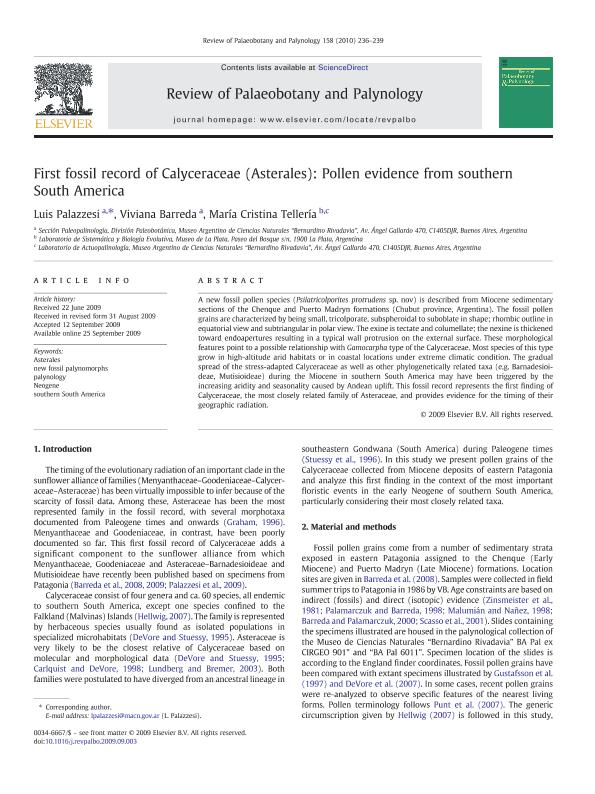Artículo
First fossil record of Calyceraceae (Asterales): Pollen evidence from southern South America
Fecha de publicación:
01/2010
Editorial:
Elsevier Science
Revista:
Review of Palaeobotany and Palynology
ISSN:
0034-6667
Idioma:
Inglés
Tipo de recurso:
Artículo publicado
Clasificación temática:
Resumen
A new fossil pollen species (Psilatricolporites protrudens sp. nov) is described from Miocene sedimentary sections of the Chenque and Puerto Madryn formations (Chubut province, Argentina). The fossil pollen grains are characterized by being small, tricolporate, subspheroidal to suboblate in shape; rhombic outline in equatorial view and subtriangular in polar view. The exine is tectate and columellate; the nexine is thickened toward endoapertures resulting in a typical wall protrusion on the external surface. These morphological features point to a possible relationship with Gamocarpha type of the Calyceraceae. Most species of this type grow in high-altitude arid habitats or in coastal locations under extreme climatic condition. The gradual spread of the stress-adapted Calyceraceae as well as other phylogenetically related taxa (e.g. Barnadesioideae, Mutisioideae) during the Miocene in southern South America may have been triggered by the increasing aridity and seasonality caused by Andean uplift. This fossil record represents the first finding of Calyceraceae, the most closely related family of Asteraceae, and provides evidence for the timing of their geographic radiation.
Palabras clave:
Asterales
,
Neogene
,
New Fossil Palynomorphs
,
Palynology
,
Southern South America
Archivos asociados
Licencia
Identificadores
Colecciones
Articulos(CCT - LA PLATA)
Articulos de CTRO.CIENTIFICO TECNOL.CONICET - LA PLATA
Articulos de CTRO.CIENTIFICO TECNOL.CONICET - LA PLATA
Articulos(MACNBR)
Articulos de MUSEO ARG.DE CS.NAT "BERNARDINO RIVADAVIA"
Articulos de MUSEO ARG.DE CS.NAT "BERNARDINO RIVADAVIA"
Citación
Palazzesi, Luis; Barreda, Viviana Dora; Tellería, María Cristina; First fossil record of Calyceraceae (Asterales): Pollen evidence from southern South America; Elsevier Science; Review of Palaeobotany and Palynology; 158; 3-4; 1-2010; 236-239
Compartir
Altmétricas




